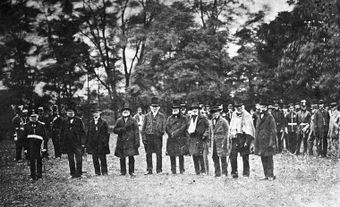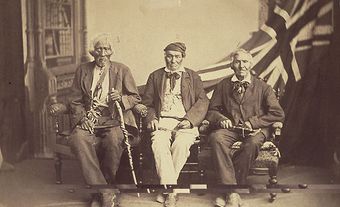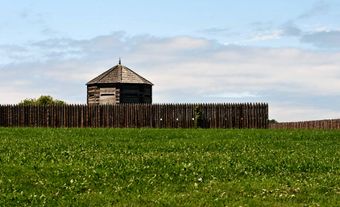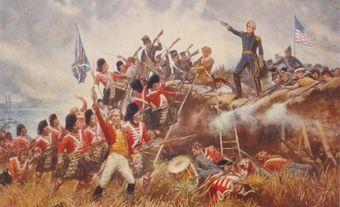A crushing defeat for the British in the War of 1812, the sacking of York began on the morning of 27 April 1813. At dawn, a flotilla of 16 American ships under Commodore Isaac Chauncey made its way to the capital of Upper Canada, York [Toronto]. Landing to the west, the Americans suppressed the small group of warriors defending the shore, while knocking out the town's meagre batteries. The American force of approximately 1,700 men easily assumed control. With the fort poorly defended by an undersized garrison of 700 soldiers and backed by an unenthusiastic (indeed, almost wholly absent) militia, the British general, Sir Roger Hale Sheaffe, retreated. He left behind two local militia officers to negotiate the terms of surrender.

Destruction and Casualties at York
To circumvent looting, Sheaffe ordered all valuables to be destroyed. A ship, the Sir Isaac Brock, then under construction, was burned; the naval stores were destroyed; and the grand magazine at the fort was set on fire. This last act of defiance, later seen by the Americans as a deliberate, cruel trick, was devastating. The ammunition and powder stored in the stone-built magazine exploded, launching heavy rocks and debris through the ranks of the American forces and spewing a terrifying column of smoke and flame into the air.The blast instantly killed nearly 40 men and wounded more than 200, many of whom did not survive their injuries. Included in the list of dead was Brigadier-General Zebulon Pike, the American commander on shore. The strain on American medical resources was enormous. British casualties were also heavy, reported at more than 150 killed and wounded, and 290 captured. The loss of naval and military stores was equally crippling, particularly for the British efforts on Lake Erie.
The residents of York were not excluded from the suffering; over the course of their six-day occupation, American troops sacked any home they found deserted, along with several businesses and public buildings. (Perhaps in an effort to generate amity with the Canadians, at least some of this booty was redistributed among them.) The Americans then set fire to the Parliament, Government House, and several other public buildings, and destroyed the local printing press. The Americans claimed that they were seizing public goods intended to support the British forces. An apocryphal tale about a scalp hanging in a government building was also used to justify the destruction, as it supposedly provided damning evidence of British collusion with "savage" warriors.
Impact of the Battle of York
The capture of the capital was an embarrassment for the British, exposing fatal inadequacies in their defences. Indeed, so poorly defended was the town that Chauncey returned in July, landing unopposed to burn several public buildings and boats, destroy a lumber yard, and make off with supplies. The British attack on Washington in August 1814 was seen as just retaliation.
For the Americans, the sacking of York was a politically important victory. Following months of ineffective campaigning, it was a much-needed boost to both military and civilian morale. It was also used as an election strategy. Facing increased competition from antiwar Federalists, many pro-war Republicans in Washington believed that a major military victory would sway voters. The actual invasion of York occurred after the election, but proclamations of victory were issued in advance, indicating the symbolic significance (and easy pickings) of the target.
See also War on the Lakes in the War of 1812.

 Share on Facebook
Share on Facebook Share on X
Share on X Share by Email
Share by Email Share on Google Classroom
Share on Google Classroom





